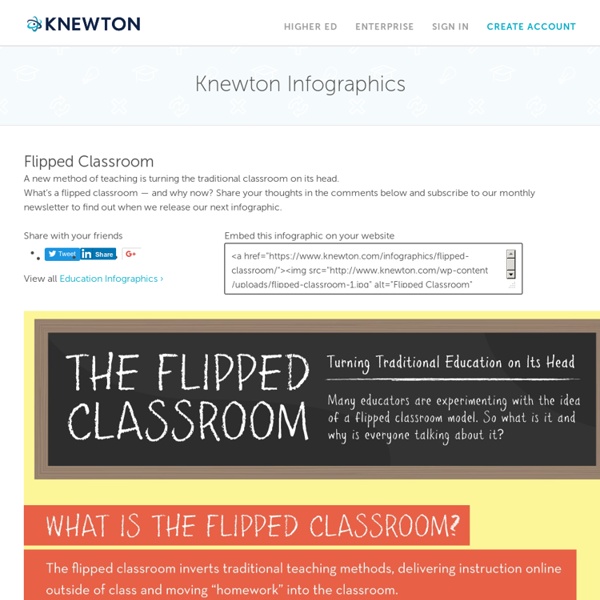



The 6-Step Guide To Flipping Your Classroom Embed Code Embeded for hosted site: Click the code to copy <div class='visually_embed'><img class='visually_embed_infographic' src=' alt='The 6-Step Guide To Flipping Your Classroom' /><div class='visually_embed_cycle'></div><script type='text/javascript' src=' Embeded for wordpress.com: <div class='visually_embed'><iframe width='1' height='1' style='width: 1px ! Customize size
Flipped Classroom Resources The traditional pattern of education is to have classroom lectures, in which the teacher explains a topic, followed by homework, in which the student does exercises. In flip teaching, the student first studies the topic by himself, typically using video lessons created by the teacher, and classtime is used to work through assignments. This format allows teachers to answer individual student's questions and create interactive learning activities. General Info PBS LearningMediaLearn how to flip your classroom with PBS LearningMedia. Flipped Classroom: Beyond the VideosThe author, Caitlin Tucker, describes what happens in her classroom and suggests three things that could make the move to the model more appealing to teachers. Flipping Your Classroom with UEN UEN offers several resources to help you teach using the flipped classroom model. NROC HippocampusUEN partners with NROC to bring you high-quality courses that can be used as a standalone or supplement in a flipped classroom.. Videos
Blended Learning Toolkit What Is Blended Learning? | LMS by Mindflash Login Login What Is Blended Learning? Blended learning is a term increasingly used to describe the way e-learning is being combined with traditional classroom methods and independent study to create a new, hybrid teaching methodology. It represents a much greater change in basic technique than simply adding computers to classrooms; it represents, in many cases, a fundamental change in the way teachers and students approach the learning experience. It has already produced an offshoot – the flipped classroom – that has quickly become a distinct approach of its own. No single, reliable definition of blended learning exists, or even a universal agreement on the term itself. A learning model in three parts There is a general consensus among education innovators that blended learning has three primary components: A course created in a blended learning model uses the classroom time for activities that benefit the most from direct interaction. Blended learning redefining teaching roles About Product
Flipping the Classroom “Flipping the classroom” has become something of a buzzword in the last several years, driven in part by high profile publications in The New York Times (Fitzpatrick, 2012); The Chronicle of Higher Education (Berrett, 2012); and Science (Mazur, 2009); In essence, “flipping the classroom” means that students gain first exposure to new material outside of class, usually via reading or lecture videos, and then use class time to do the harder work of assimilating that knowledge, perhaps through problem-solving, discussion, or debates. In terms of Bloom’s revised taxonomy (2001), this means that students are doing the lower levels of cognitive work (gaining knowledge and comprehension) outside of class, and focusing on the higher forms of cognitive work (application, analysis, synthesis, and/or evaluation) in class, where they have the support of their peers and instructor. What is it? | Does it work? | Theoretical basis | Key Elements | Where can I learn more? What is it? Flipped Classroom
investigate F.C. METHODOLOGY What is Flipped Classroom Methodology? The flipped classroom methodology of learning has shown us that technology will never remove the need for classroom-based learning. Instead, it will help it to evolve in exciting new ways. Here, we show you some practical ways that GoConqr can help support changes in the classroom. The flipped classroom methodology is a form of blended learning that focuses on getting students to engage more with their learning material. How is it Effective? Educators who’ve used the flipped classroom methodology believe that it supports active rather than passive learning as students are afforded the time they need to process information before they enter the classroom. While the standard learning model uses more time engaging lower cognitive functions such as receiving information and understanding it, the flipped classroom methodology approach allows educators to spend more time on higher cognitive applications such as analysis, evaluation and application.
The Jigsaw Classroom A Visual Chart on Summative Vs Formative Assessment February 5, 2014 This post is born out of a discussion I had with a fellow teacher on the Facebook page of Educational Technology and Mobile Learning on the differences between summative and formative assessment. Luckily this discussion coincided with me reading Frey and Fisher's book " Literacy 2.0 : Reading and Writing in The 21st Century Classroom." and there was a section in which the authors talked about these differences in a subtle way by referring to formative assessment as assessment for learning and summative assessment as assessment of learning. However, knowing that several of you might probably need a refresher about these concepts I went ahead and created the visual below for you to keep as a reminder. I invite you to have a look and share with your colleagues.